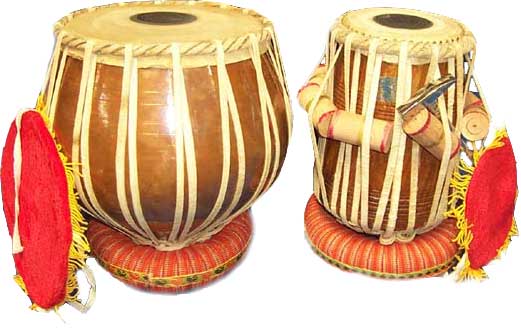
A publication of the Batish Institute of Music and Fine Arts

 Production of tabla bols is a trying art. It is not difficult, once you see how its done. If you don't ever buy another book/cassette/video, you should think seriously about my Tabla Video Tutor #2 - Production of Tabla bols. It has one of the biggest collections of tabla bols including 2, 3, and 4 beat combinations. Also included are combination bols where the tabla / dagga drums are struck simultaneously to produce sounds. I have seen so many students falter in their tabla studies because they just couldn't "get it". Not for lack of trying but more because their instruction in bol production was either hindered due to poor class schedule, poor instructions from their teacher, or perhaps they simply ran out of money to take more lessons. Sometimes you have to take 3 - 4 lessons to get this information properly ingrained. I received a call from a user of my tutor who expressed his delight at learning in a couple of weeks what he had had trouble learning in the last five years from his tabla teacher! No amount of self teaching or gazing at photographs is going to help you play the tabla bols properly, no matter how good the writing of any work. This applies also to learning via audio cassettes although the audio medium is better than learning from a photo. Still, it leaves too much to your imagination. You will end up acquiring very bad habits that will be difficult to undo. This is an art that has to be seen to be played properly. So don't hesitate in this decision! The beauty of a video tutor is the luxury of the rewind and the freeze frame buttons :) Proper Sitting PositionBefore doing anything, you must get your sitting position, and your hand positions in good form. I cover this in detail in my Tabla Tutor #1.The most common method is to sit squating on the floor with the dagga to your left and the tabla to your right. The drums are tilted slightly forward so as to afford a comfortable resting place fro your hands.
TaaThis bol is produced on the chanti of the tabal. Some tabla players call this area "kinar". Chanti meant a sharp bell type of a sound and "kinar" literally means "edge". In either case, this bol is produced by striking the rim of the tabla with your index finger.Upcoming LessonsHow to Tune your Tabla drumsSome basic Tabla Bols Left and right hand placement Tabla Paraphenalia And much more! So come on back..... Now available.... Tabla Video Tutors by Ashwin Batish.Check out these exciting new Tabla Video Tutors by Ashwin Batish. Each video covers a lot of ground. It's the next best thing to having a teacher present! And..... you can freeze frame, rewind, or fast forward an many times as you like! For the cost of a lesson you can now own the lesson on video! Tabla Tutor #1 is an "Introduction to Tabla" and Tabla Tutor #2 has one of the largest collection of bols. Tabla Tutor #3 will teach you how to play some of the standard rhythm cycles!
Other Issues:1 • 2 • 3 • 4 • 5 • 6 • 7 • 8 • 9
Please Note: All content is copyright ©2003 Ashwin Batish. All rights reserved. Unauthorized copying, photocopying, transmitting this document on hard paper or electronically or by any other means is strictly prohibited and unlawful. You have our permission to link to this page.
|